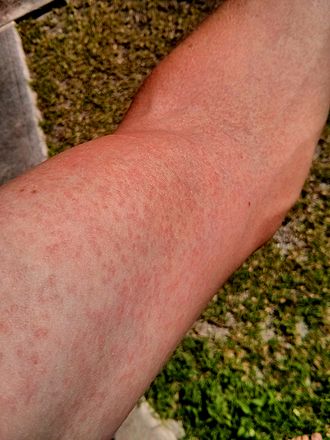Zika virus: Difference between revisions
Jump to navigation
Jump to search
| Line 34: | Line 34: | ||
{{col-end}} | {{col-end}} | ||
ZIKV has also been proven to be sexually transmitted between humans by Brian Foy, a biologist at Colorado State University, in 2009. <ref>{{Cite journal | last1 = Foy | first1 = B. D. | last2 = Kobylinski | first2 = K. C. | last3 = Foy | first3 = J. L. C. | last4 = Blitvich | first4 = B. J. | last5 = Travassos Da Rosa | first5 = A. | last6 = Haddow | first6 = A. D. | last7 = Lanciotti | first7 = R. S. | last8 = Tesh | first8 = R. B. | doi = 10.3201/eid1705.101939 | title = Probable Non–Vector-borne Transmission of Zika Virus, Colorado, USA | journal = Emerging Infectious Diseases | volume = 17 | issue = 5 | pages = 880–882 | year = 2011 | pmid = 21529401 | pmc =3321795 }}</ref> | ZIKV has also been proven to be sexually transmitted between humans by Brian Foy, a biologist at Colorado State University, in 2009. <ref>{{Cite journal | last1 = Foy | first1 = B. D. | last2 = Kobylinski | first2 = K. C. | last3 = Foy | first3 = J. L. C. | last4 = Blitvich | first4 = B. J. | last5 = Travassos Da Rosa | first5 = A. | last6 = Haddow | first6 = A. D. | last7 = Lanciotti | first7 = R. S. | last8 = Tesh | first8 = R. B. | doi = 10.3201/eid1705.101939 | title = Probable Non–Vector-borne Transmission of Zika Virus, Colorado, USA | journal = Emerging Infectious Diseases | volume = 17 | issue = 5 | pages = 880–882 | year = 2011 | pmid = 21529401 | pmc =3321795 }}</ref> | ||
Mosquito-borne ZIKV is thought to initially replicate in dendritic cells near the site of [[Inoculation|inoculation]] before spreading to lymph nodes and then the bloodstream.<ref name="pmid19788800"></ref> | Mosquito-borne ZIKV is thought to initially replicate in dendritic cells near the site of [[Inoculation|inoculation]] before spreading to [[Lymph node|lymph nodes]] and then the [[Blood|bloodstream]].<ref name="pmid19788800"></ref> | ||
==Refererences== | ==Refererences== | ||
{{Reflist|2}} | {{Reflist|2}} | ||
Revision as of 16:00, 15 December 2015
This page is about microbiologic aspects of the organism(s). For clinical aspects of the disease, see Zika virus infection.
Editor-In-Chief: C. Michael Gibson, M.S., M.D. [1]; Associate Editor(s)-in-Chief: Nate Michalak, B.A.
| Zika virus | ||||||||
|---|---|---|---|---|---|---|---|---|
 rash on arm due to Zika virus
| ||||||||
| Virus classification | ||||||||
|
Organism
- Zika virus, also known as ZIKV, is an enveloped, icosahedral virus with a single-stranded, positive sense RNA genome. The most closely related virus is the Spondweni virus and is one of the two viruses in the Spondweni virus clade.[1]
- The ZIKV genome consists of 10,794 nucleotides that encode 3,419 amino acids[2]
- ZIKV is a member of the Flaviviridae family and of the flavivirus genus.
- There are two lineages for ZIKV: African and Asian.[2]
Human Pathogen
Transmission of ZIKV to humans is believed to occur through infected mosquitoes. The following species have been identified as vectors for the virus:[3]
|
|
ZIKV has also been proven to be sexually transmitted between humans by Brian Foy, a biologist at Colorado State University, in 2009. [4] Mosquito-borne ZIKV is thought to initially replicate in dendritic cells near the site of inoculation before spreading to lymph nodes and then the bloodstream.[2]
Refererences
- ↑ FIELDS, B. N., KNIPE, D. M., & HOWLEY, P. M. (2007). Fields virology. Philadelphia, Wolters Kluwer Health/Lippincott Williams & Wilkins.
- ↑ 2.0 2.1 2.2 Hayes EB (2009). "Zika virus outside Africa". Emerg Infect Dis. 15 (9): 1347–50. doi:10.3201/eid1509.090442. PMC 2819875. PMID 19788800.
- ↑ Duffy, Mark R.; Chen, Tai-Ho; Hancock, W. Thane; Powers, Ann M.; Kool, Jacob L.; Lanciotti, Robert S.; Pretrick, Moses; Marfel, Maria; Holzbauer, Stacey; Dubray, Christine; Guillaumot, Laurent; Griggs, Anne; Bel, Martin; Lambert, Amy J.; Laven, Janeen; Kosoy, Olga; Panella, Amanda; Biggerstaff, Brad J.; Fischer, Marc; Hayes, Edward B. (2009). "Zika Virus Outbreak on Yap Island, Federated States of Micronesia". New England Journal of Medicine. 360 (24): 2536–2543. doi:10.1056/NEJMoa0805715. ISSN 0028-4793.
- ↑ Foy, B. D.; Kobylinski, K. C.; Foy, J. L. C.; Blitvich, B. J.; Travassos Da Rosa, A.; Haddow, A. D.; Lanciotti, R. S.; Tesh, R. B. (2011). "Probable Non–Vector-borne Transmission of Zika Virus, Colorado, USA". Emerging Infectious Diseases. 17 (5): 880–882. doi:10.3201/eid1705.101939. PMC 3321795. PMID 21529401.